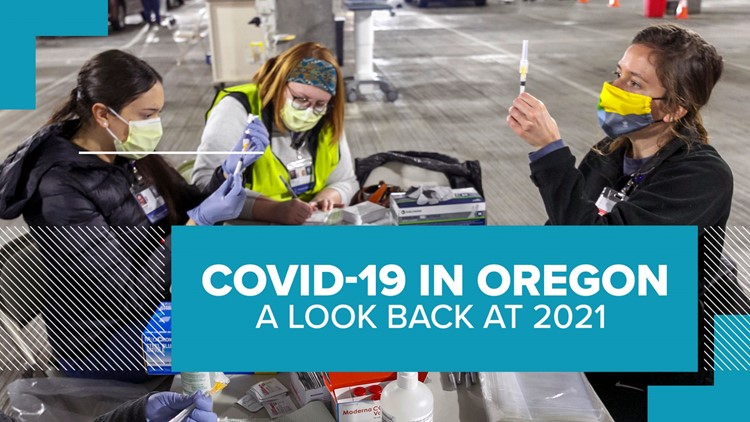PORTLAND, Ore. — It has been two years that Oregonians have been living in pandemic conditions. We have come a long way from the state being shut down, to kids returning to school, to watching our hospitals' ICUs fill to and past capacity. Here’s a look back at coronavirus in Oregon in 2021:
Adjusting to the new normal
Year two of living with the coronavirus equipped the world, and Oregonians, with coping mechanisms for a "new normal," a tiresome way to put into perspective all the ways life changed as the pandemic pressed on.
Early in 2021, just three days in, Oregon met a grim milestone of 1,500 COVID-related deaths. Oregon Health Authority (OHA) released daily and weekly statistics on COVID-19 in the state in 2020. By 2021, it had ironed out many of the kinks, making a dashboard available to the public to track COVID-19 in the state.
Another indicator that the state had learned from a year of quarantine was the state’s announcement that kids would return to in-person learning. On March 5, Governor Brown announced that all Oregon public schools had to offer universal access to in-person learning by the end of the month. The promise of kids returning to school seemed to be the beginning of a series of events that really would inch Oregon closer to normalcy.
Oregon businesses began hiring previously laid-off employees back, to-go cocktails were made a permanent Portland fixture and Gov. Brown announced that the state would reopen on June 30.
However, the delta variant reached Eastern Oregon in July. It was only a matter of weeks before it spread across the state, becoming the dominant strain, according to health officials. Roughly two weeks after the first delta case was found in Malheur County, 88% of cases in Oregon were identified to be the delta variant, which health officials said was spreading faster than the original strain and impacting mostly unvaccinated people.
Come August, an indoor mask mandate was put into place as delta continued to hammer communities across Oregon, which was shortly followed by an outdoor mask mandate as well. And despite the state’s best efforts to get kids into in-person learning, some school districts in rural counties did not immediately open to the in-person model as COVID cases rose once again. In another push to get kids into school, the state-mandated that all K-12 and health care workers would need to be fully vaccinated by Oct. 18 or face termination. At that time, Oregon was facing a record number of hospitalizations that began overwhelming hospitals across the state. The vaccine mandate, which later encompassed government workers as well, was among the strictest mandates in the country.
In November, Oregon surpassed another grim milestone: 5,000 COVID-related deaths. Despite this sad news, hospitalizations had slowed from their peak to the point where, just the following day, the outdoor mask mandate was lifted.
Many sectors, like education and health care, are still navigating the challenges of COVID. Schools are facing historic staffing shortages that were worsened by the pandemic all while trying to provide resources for students like vaccine clinics and COVID testing programs.
Health care workers who spoke with KGW all echoed a similar sentiment from this last year: they’re overwhelmed.
Hospitals face the rising pressure of delta cases
In June, 6 weeks or so before the delta variant was first recorded to have been found in Eastern Oregon, hospitals across the state were already facing staffing shortages. Thirty National Guard members were sent to Oregon State Hospital to help with the shortage there.
Health officials knew Oregon was facing an unstoppable wave of COVID cases and the smaller hospitals in the state were the first indication of what Oregon was in for. Smaller hospitals started to become overwhelmed with COVID patients weeks before COVID was expected to peak. Then in August, after delta had become the dominant strain in Oregon, even larger hospitals like Oregon Health & Science University (OHSU) began limiting visitors as the state saw record-breaking hospitalization numbers causing a surge of patients.
Within that same month, health care workers were begging for Oregonians to be vaccinated as the delta variant was hitting the unvaccinated population the hardest across the country. Legacy Health paused nonessential surgeries to help deal with the surge of COVID patients and it was just the first of several area hospitals to do that. One patient spoke to KGW about her jaw surgery that was delayed. While the surgery wasn’t life-saving, and thus deemed nonessential, she was in pain and unable to eat.
The crisis rose to such levels that an additional 500 traveling health care personnel were dispatched to Oregon to help alleviate some of the pressure.
KGW documented this struggle in its two-part special “Overwhelmed: Inside Oregon’s ICUs,” which was a frank look at the dire situation in some of Oregon’s most packed ICUs. Nurses and doctors spoke of the tragedy they found themselves surrounded by, including younger, sicker patients that had to be placed in hallways or other places because ICUs were at capacity. The first part saw KGW’s Pat Dooris inside an ICU in Bend, the second saw Christine Pitawanich inside an ICU in Portland.
Through the thick of it all, health care workers in press conferences begged Oregonians to be vaccinated against the coronavirus. It’s hard to argue that anything changed the landscape of this year more than vaccines did.
Vaccinations in Oregon
Like most places across the U.S. and the world, vaccines came out in phases in Oregon.
In January, as part of her effort to open schools to in-person learning, Gov. Kate Brown announced that teachers and school staff would be prioritized over seniors in getting vaccinated. This went against advice from the Centers for Disease Control and Prevention (CDC). She faced backlash for it but stood firm on her decision to get students back into in-person learning.
In April 2021, it was announced that anyone 16 years old or older was eligible to get a vaccine. The mass vaccination sites across Oregon, including the one at PDX and the one at the Oregon Convention Center, saw near-constant long lines for months and months as people scrambled to get vaccinated.
Beginning in May, the Oregon Convention Center mass vaccination site opened up to walk-in appointments, making the vaccine even more widely available.
Oregon was reaching for a 70% vaccination goal, which it hit in early July. But in a push to protect Oregon as delta pressed in, K-12 staff, volunteers and later government workers were required to be vaccinated by Oct. 18 or face termination. A number of agencies pushed back against the mandate, including some of Oregon’s first responders.
When the deadline rolled around, places like Legacy Health reported their vaccination numbers having jumped from being around 80% of its workforce to being more than 90%. However, not everyone was compliant, and those who weren’t did lose their jobs.
While vaccine passports were never a mandatory statewide action, several bars, restaurants and venues implemented their own policies requiring proof of vaccination. Proof could be shown in a number of ways including your vaccination card or a photo of it. This spurred fake and blank vaccination cards to show up on online marketplaces, including a local listing in Oregon. The Oregon Attorney General and the FBI warned that the sale was illegal and could put lives at risk.
As the demand for the vaccine slowed, the mass vaccination sites at PDX and the Oregon Convention Center closed down. But vaccination didn’t halt in the state, with a number of community organizations holding vaccination clinics in some of the places in the Portland metro where COVID affected the community disproportionately.
But with the Pfizer vaccine being approved for all children ages 5-11 in Oregon in Washington on Nov. 3, and boosters being available to everyone, vaccination efforts are ramping up once more with mass vaccination events being held by many counties at fairgrounds, hospitals, parks and community centers.
It’s not too late to be vaccinated and health officials are recommending that you don’t wait to get your booster if you are eligible as omicron continues to be a “variant of concern.”
Looking to the future
Omicron is the latest variant to cause concern across the world. COVID numbers in Oregon are looking the best they have all year when it comes to the number of cases, deaths, and hospitalizations continuing to decrease. Health officials are still unsure how omicron will impact Oregon because there is still a lot to learn about this variant.
Pfizer found that a booster dose of its vaccine offered protection against omicron as well, as did Moderna in an announcement released on December 20.
Children are continuing to be vaccinated and booster shot appointments continue to be difficult to find, indicating that people are receiving their boosters, too.
So, while Oregon does look different through the lens of COVID-19, things have shifted somewhere closer to the normal we remember. Things like going out to eat, to a Timbers game, a concert or the Moda Center seemed like distant memories in 2020 but came back into a lot of our realities in 2021.
Now that the omicron variant has reached Oregon, health experts urge Oregonians to do what they’ve been doing for two years: get vaccinated, wear a mask, wash your hands, observe social distancing measures and look out for one another.
Destiny Johnson is a digital reporter at KGW. She hosts a Nerd News YouTube show and often writes about crime. You can follow her on Twitter at @hello_destiny.



